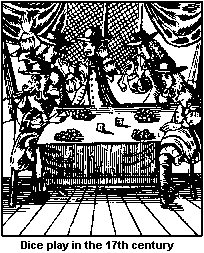|
|||||||||||||||||||||||||||||||||||||||||||||
|
| |||||||||||||||||||||||||||||||||||||||||||||
|
Dice History Dice are the oldest gaming implements known to man. Their precise origins are unknown but they have a long and rich history none-the-less. Sophocles (496 - 406 BC), the Greek poet and tragedian, claimed that dice were invented by the Greek, Palamedes, during the siege of Troy. Herodotus (b. 484 BC?), historian and acquaintance of Sophocles, said they were invented by the Lydians of Asia Minor. But dice date back further than this. Egyptian tombs, dated to 2000 BC, have been found containing dice and dice reputedly dated to 6000 BC have been uncovered in archaeological excavations. Dice were developed independently by many ancient cultures all over the world and did not simply originate and spread from any one place. In ancient times the throw of a dice was not just considered to be luck, the outcome was believed to be controlled by the gods, and casting dice was a way of dividing inheritances, choosing rulers and as a method of prediction. The Roman goddess, Fortuna, daughter of Zeus (known to gamblers as Lady Luck), was believed to determine the outcome of a throw. Before standard cubical dice became common, ancient peoples would use fruit stones, sets of flat sticks, sea shells, nut shells and pebbles to get random results for games. These were probably adopted from witch doctors and shaman who would throw them to gain insight and knowledge of the unknown and things to come. Fortune telling with standard ordinary dice is still practised to this day.
Of course
games have been played with dice from their early beginnings. The first
were probably simple racing games and have been lost to history. The Dominoes probably descended from dice in China and spread to the West during the 18th-century while standard ordinary dice became the vital component of a vast array of commercial board games in the 19th and 20th-centuries. In recent times polyhedral dice have gained widespread popularity with the advent of Role Playing Games (RPGs) and modern technological advances in plastic moulding . Whether it's the old standard six-sided cube with spots or the latest polyhedral shape, dice are still the game player's most vital, versatile and treasured piece of equipment.
There is a lot more to be written about the history of dice and links to new articles will be added to this page over time. Bookmark dice-play and come back to learn more.
|
||||||||||||||||||||||||||||||||||||||||||||
|
Copyright © 2022 Stormdark I.P. and Media. All rights reserved.
www.dice-play.com This site is for
personal use only and content may not be copied or reproduced in any form for any
purpose. Terms &
Conditions
Advertising
UK sports betting sites not on gamstop
|
|||||||||||||||||||||||||||||||||||||||||||||

 Animal knucklebones were the next step in the evolution of dice.
The Greeks and Romans used sheep anklebones as well as the more developed
cubical spotted dice. The Romans called the four-sided anklebones Tali
or Astragali and the standard six-sided dice Tesserae. The Arab
word for knucklebones is the same word they use for dice. Playing
with dice is still known as "rolling the bones" to this day.
Animal knucklebones were the next step in the evolution of dice.
The Greeks and Romans used sheep anklebones as well as the more developed
cubical spotted dice. The Romans called the four-sided anklebones Tali
or Astragali and the standard six-sided dice Tesserae. The Arab
word for knucklebones is the same word they use for dice. Playing
with dice is still known as "rolling the bones" to this day.  pharaohs of ancient Egypt were portrayed playing with dice and both the
Romans and Greeks were keen dice players. Roman Emperors notoriously
played and gambled with dice compulsively.
pharaohs of ancient Egypt were portrayed playing with dice and both the
Romans and Greeks were keen dice players. Roman Emperors notoriously
played and gambled with dice compulsively.